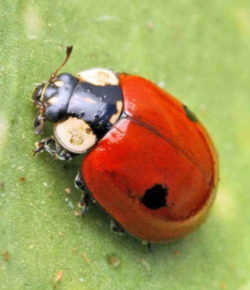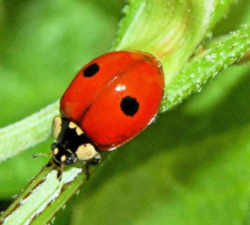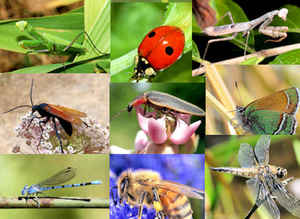
Massachusetts Symbols
Massachusetts State Insect
Ladybug

(Adalia bipunctata)
Adopted in 1974.
The ladybug, (Adalia bipunctata,) was adopted as the official state bug or insect symbol of Massachusetts in 1974 thanks to a campaign that began in 1974 by a second-grade class in the town of Franklin. Also lady beetle, ladybird, ladyfly, etc. Most common in the state is the Two-Spotted Lady Beetle, (Adalia bipunctata.) Its head is black with pale yellowish margins; elytra reddish, with two black spots.
It helps farmers by controlling insect pests, especially aphids. In folk medicine, ladybugs were believed to cure various diseases such as colic and measles. In folk medicine ladybug beetles were used to cure various diseases including colic and the measles.
The Ladybug is the Official State Insect of six states; New York, North Dakota, Ohio, Massachusetts, New Hampshire and Tennessee. The Lady Bug is the Official State "Bug" of Delaware.
Massachusetts State Insect : Ladybug

The Coccinellidae are a family of small beetles, ranging from 0.8 to 18 mm. They are commonly yellow, orange, or red with small black spots on their wing covers, with black legs, heads and antennae. Coccinellids are known as ladybugs in North America, and ladybirds in other areas. Coccinellids are found worldwide, with over 6,000 species described. Entomologists in the United States widely prefer the names ladybird beetles or lady beetles as these insects are not true bugs.
Characteristics of the Ladybug
Adults
Adult two-spotted lady beetles are 4-5mm long, and ovoid in shape. The head and thorax is black with yellow markings. Their undersides are black to reddish-brown; Their elytra (wing covers) are orange with one black spot on each side. The larvae are elongate, with soft bodies, and are black with yellow and white spots (they look a little like tiny alligators) (Marshall 2000, Milne & Milne 2000).
Defense
Bright colors generally indicate that the insect is armed and dangerous! In this case the ladybird is advertising it's bitter taste. When handled the ladybird will exude drops of pungent fluid which stain the hand and taint it with a long-lasting smell.
Reproduction
Females deposit bright yellow eggs on the underside of leaves and other locations near potential food sources for the larvae. Pupae are black with yellow dots and are found hanging from leaf surfaces. Adults in the North live through the winter; there can be more than one generation in a year.
Behavior
Adults overwinter in large groups under logs, leaves, and bark. They occasionally enter buildings by accident, looking for a sheltered place to hibernate. If they get into a heated house they may be doomed, as the warmth keeps their metabolism going, and they may use up their fat and water reserves before spring.
Feeding:
As with most in this family, ladybirds will eat huge numbers of aphids in both the larval and adult stages
LARVA: carnivorous, aphids
Some Facts About Ladybugs:
- Ladybugs are the most popular and widely used beneficial insects for commercial and home use. Ladybugs are capable of consuming up to 50 to 60 aphids per day but will also eat a variety of other insects and larvae including scales, mealy bugs, leaf hoppers, mites, and various types of soft-bodied insects, and are one of the most active predators, searching from dawn to dusk for food.
- Ladybugs will consume over 5,000 aphids each in their lifetime. Pollen and nectar are necessary for maturation of newly emerged ladybug adults, particularly before a winter hibernation season. Adults can survive on pollen and nectar for limited periods, but a supply of aphids or other prey is necessary for egg production.
- Ladybugs become active at about 59 degrees Fahrenheit.
- Ladybugs are cold-blooded and hibernate in cold weather.
- There are nearly 5,000 different kinds of ladybugs worldwide - 400 of which live in North America.
- A ladybug's top flying speed is about fifteen miles per hour.
- Ladybugs lay their eggs where aphids are present. Both lady bugs and their larvae eat aphids. The eggs of ladybugs are not visible to the naked eye.
- A female ladybug will lay more than 1000 eggs in her lifetime.
- Ladybugs are a type of beetle. All species of ladybugs have short legs. This separates them from other beetles.
- Ladybugs chew from side to side and not up and down like people do.
- The Ladybug is the Official State Insect of six states; New York, North Dakota, Ohio, Massachusetts, New Hampshire and Tennessee. The Lady Bug is the Official State "Bug" of Delaware.
- A ladybug excretes a yellowish liquid when it is threatened. The liquid has a terrible smell to its predators.
- The Asian Lady "Beetle" can live up to 2-3 years if the conditions are right.
The Ladybug Story: A Story About Lawmaking
Published by William Francis Galvin
Secretary of the Commonwealth
Tours and Government Education Division
State House, Room 194
Boston, Massachusetts 02133
Telephone: 617-727-3676
updated 10/97
This is a true story of how a second grade class helped to make a new state law. It shows how anyone with a good idea can change the world a little
bit. I hope you enjoy reading it and understanding how rewarding the legislative process can be.
William Francis Galvin
Secretary of the Commonwealth
This is a true story about Ms. Pamela Johnson's second grade class at the Kennedy School in Franklin, Massachusetts.
One day, Ms. Johnson told the class that, by law, there is a state bird - the chickadee - and state tree - the American Elm - and a state fish - the
cod.
"What about a state bug?" somebody asked, "do we have one?"
"No," said the teacher.
"I think there should be a state bug," said one little boy.
"I think so too," said a little girl, "and I think it should be a ladybug." All of the children agreed.
"What a good idea," said their teacher. "Maybe our class can make the ladybug the state bug. Maybe we can help make it a law!"
All of the boys and girls began to talk excitedly. They agreed that they would like very much to try. It would take a long time, the teacher told them,
but in the end it would be worth it.
The class learned that everyone who lives in Massachusetts has the right to give legislators, the men and women who make the laws, ideas for new laws.
This right is called the right of free petition.
So Ms. Johnson wrote to the State House, the capitol building in Boston, and in a few days the class received a petition form. They wrote their idea
about a state bug on the special form.
Then, Ms. Johnson told them, they would have to get their petition signed by a legislator. She explained that there are two kinds of legislators: representatives,
who speak for one or two towns, and senators, who speak for several towns. They found out that their town, Franklin, has its own senator and its own
representative. So the children wrote to their representative.
He wrote back to say that he would be glad to sign the petition.
After their petition was signed, it began its long journey to becoming a law.
The class decided to find out everything that would happen to their petition on its journey and make sure to be there when anything important happened
along the way.
First, their petition had to become a bill. The House Clerk in the House of Representatives takes care of this. He read their ladybug petition and
gave it its own number, H.5155.
Then, he had to decide which of the committees in the House of Representatives to send the bill to. Different committees study different kinds of subjects.
When the House Clerk picked the right committee, he had copies of the bill made and sent to all of the senators and representatives on the committee,
so they could study it.
Meanwhile, at school, the children in Ms. Johnson's class were busy making ladybug costumes to wear when the time came for them to visit the State
House. They wanted to show everyone there how much they really cared about making the ladybug the official bug!
When the class heard which committee was studying their bill, they wrote to find out when their bill would be "heard." A committee has a
public hearing for each bill it studies. At a hearing, anyone can come and say why he or she thinks a bill should or should not be made a law or passed
into law.
On the day of the public hearing, Ms. Johnson's second grade class dressed in ladybug costumes got on the yellow school bus and rode all the way to
Boston to the State House. They walked inside the enormous building with the shiny golden dome and into the room where the hearing was being held.
They wanted to testify - to tell the legislators about their idea.
When it was their turn, some of the boys and girls stood up and told the legislators why they thought it would be a wonderful idea to make the ladybug
the official state bug.
"They're so beautiful with their shiny orange backs and bold black spots," they said, "and they can be found in everyone's backyard."
The committee listened very carefully while the children explained how they felt. Then the committee had to decide what to tell all the legislators,
who would later vote on the new idea. You will be glad to hear that the committee told the House of Representatives that they believed the ladybug
bill should be passed into law! The class was very happy.
A few weeks later, Ms. Johnson's class got back on the school bus and headed for Boston. It was the day that all of the representatives were going
to discuss the ladybug bill for the first time.
This time the class went to the beautiful chambers of the House of Representatives. They stood high up in a balcony where they could see and hear everything
that was happening.
The class found out that there are three readings of every bill before a final vote can be taken. So between the three readings, the class visited
some of the representatives in their offices and wrote to others to ask them to vote for the bill.
The House of Representatives voted for the ladybug bill, and then sent it to the Senate to be read and voted on again. The children once again returned
to Boston and this time they sat in the gallery of the Senate chamber to hear the Senators talk about the ladybug bill. The Senate also liked the bill
and wanted it to be made into a new law. The children cheered!
Now the bill was printed on very special paper called parchment and sent back to the House of Representatives for a final vote called enactment. Soon,
the Senate also did the same.
At last, the bill could go to the governor. If he agreed that the ladybug should be the state bug, he would sign the bill. The governor agreed! He
invited Ms. Johnson's second grade class to be there when he wrote his signature on the bill.
They all wore their best clothes and piled once again into the bus to make the last, familiar journey to the State House in Boston. They walked up
the grand staircase to the governor's office and watched as he signed their bill into law.
They were very proud.
And that is how the ladybug came to be the official state bug of Massachusetts.
Massachusetts Law
The law designating the lady bug as the official Massachusetts state insect or insect emblem is found in the General Laws of Massachusetts, Part 1, Title 1, Chapter 2, Section 12.
PART I. ADMINISTRATION OF THE GOVERNMENT.
TITLE I. JURISDICTION AND EMBLEMS OF THE COMMONWEALTH, THE GENERAL COURT, STATUTES AND PUBLIC DOCUMENTS.
CHAPTER 2. ARMS, GREAT SEAL AND OTHER EMBLEMS OF THE COMMONWEALTH.
SECTION 7.
Chapter 2: Section 12 Insect or insect emblem of commonwealth
Section 12. The lady bug shall be the insect or insect emblem of the commonwealth.
Taxonomic Hierarchy: Lady Bug
Kingdom: Animalia (Animals)
Phylum: Arthropoda (Arthropods)
Subphylum: Hexapoda (Hexapods)
Class: Insecta (Insects)
Order: Coleoptera (Beetles)
Suborder: Polyphaga (Water, Rove, Scarab, Long-horned, Leaf and Snout Beetles)
No Taxon: (Series Cucujiformia)
Superfamily: Coccinelloidea
No Taxon: (Coccinellid group)
Family: Coccinellidae (Lady Beetles)
Subfamily: Coccinellinae
Genus: Adalia
Species: bipunctata (Two-spotted Lady Beetle)
Butterflies, and Bugs







